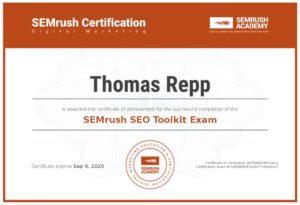 If you're still clinging to Google search rankings as the be-all-end-all of SEO, 2025 is about to slap that mindset silly. Search behavior has fractured ... and the platforms where your buyers are searching for solutions look nothing like the SEO playbook of five years ago.
If you're still clinging to Google search rankings as the be-all-end-all of SEO, 2025 is about to slap that mindset silly. Search behavior has fractured ... and the platforms where your buyers are searching for solutions look nothing like the SEO playbook of five years ago.
Google? Still relevant ... sure. But your prospects are increasingly digging into Reddit threads, LLMs like ChatGPT, YouTube explainers, even TikTok walkthroughs before they ever hit your website.
So, what’s the play?
Simple ... it’s time to stop thinking like a search marketer and start thinking like a brand builder.
This is not some fluffy, “let’s make the logo bigger” branding exercise. This is a strategic repositioning ... one that ties all of your digital efforts together and actually works across today’s fragmented search landscape.
Let’s dig in.
1. Stop Treating PR Like a Checkbox ... It’s a Growth Lever
If you’ve already been putting money and effort into PR, kudos. You’re ahead of the curve. But even then, odds are good you’re underutilizing it.
Old-school PR thinking: "Let's get backlinks from industry pubs so our domain authority climbs."
New-school PR thinking: "Let’s make sure decision-makers on Reddit, Google, and ChatGPT see us mentioned as the go-to authority in our space."
The best PR does two things:
- Positions you as a trustworthy authority to both humans and search engines.
- Creates signal density that connects your brand with the key topics you want to own.
Whether it’s your in-house team doing digital PR outreach or an outside agency,or brand advisor placing bylined articles, this isn’t about direct leads. It’s about building influence and awareness ... which leads to long-term organic demand.
Set your expectations right: You won’t always hit a home run. But a steady cadence of brand and credibility-rich mentions will make you findable in all the right places.
2. Give Your Brand a Voice ... Then Multiply It
Here’s the truth: One voice from the corner office isn't enough anymore.
Sure, get your CEO out there ... podcast interviews, thought pieces, speaking gigs. But don’t stop there. The real magic happens when multiple subject-matter experts across your org are publicly active on key issues.
This creates a matrix of voices ... each one attacking your core topics from a different angle. Engineers talking specs. Product managers talking process. Sales talking industry pain points.
And here's the kicker: When these voices are consistent and visible, you earn authority points with both your human buyers and AI-driven platforms.
Find the places where your ideal customers are listening ... industry forums, LinkedIn threads, YouTube comments. Then inject your awesome team’s expertise into those conversations with intent.
3. Build Proprietary Content Assets That Can’t Be Ignored
Content that ranks used to be about clever keyword placement and backlink volume. I have never been a fan of backlinks for the mid-size industry crowd. They are a resource hog for that market. Today’s winners bring proprietary insight to the table ... something AI and competitors can’t replicate.
Want to be seen as a first-call vendor? Give your audience something they can’t get anywhere else.
If you’re a manufacturer, publish benchmark data on cycle times. If you’re in logistics, show how lead times shift seasonally across ports. If you’re in the rotating equipment industry show buyers how your remote condition monitoring system dramatically lowers costs.
LLMs, journalists, and analysts crave this kind of differentiated data. Give them something worth citing.
Even better ... make it visual, well-structured, and easily digestible. More on that next.
4. Structure Your Data So Machines (and Humans) Understand It
Let’s get tactical. Structured data markup ... the nerdy SEO stuff most marketers glaze over ... is now a competitive advantage. That's the pivot
By tagging your content with structured schema, you make it digestible not just to Google, but to the LLMs powering modern search experiences.
If your site has a library of industry terms, case studies, or comparison pages, wrap them in structured data so AI engines can properly associate your brand with the core themes you're trying to own.
This isn’t just about search ranking ... it’s about findability across platforms.
Clean, well-structured data makes it easy for machines to connect your brand with key concepts ... and that drives visibility far beyond Google.
5. Dominate Your Owned and Partner Media Ecosystem
Your website is your launchpad, your mothership ... but your reach shouldn’t stop there. You need a network effect.
Use your owned channels ... blog, podcast, newsletter, social .... to hammer home the connection between your brand and your expertise.
Then pull your partners into the mix. Get on their podcasts. Swap blog contributions. Tag-team webinars. Align on content themes and amplify each other.
The more surfaces your industrial brand name touches in context with the right topics, the more signals you send to both humans and algorithms that brand is the authority in your niche.
6. Measure the Right KPIs for Brand-Building in SEO
If you’re only watching rankings, clicks, and CTR, you’re playing checkers. This is chess.
Here are the brand-driven metrics that matter now:
- LLM visibility: Feed queries into ChatGPT or Perplexity and track how often your brand gets mentioned.
- Brand Visibility: How many of your critical topics show up in AI driven searches?
- Brand search volume: Are more people typing your brand name into search engines over time?
- Brand referral traffic: Who’s actually clicking to your site from branded mentions across platforms?
- Third-party mentions: Are people talking about you (positively) on Reddit, YouTube, TikTok?
Track these consistently. Over time, they become leading indicators of organic strength that no SERP report can touch.
7. Use Paid Media to Kick-Start Organic Momentum
Yes, this is an SEO article. And yes, paid media plays a supporting role.
Here’s how: Smart top-of-funnel PPC campaigns ... especially on YouTube, LinkedIn, and Google Discovery ... can drive brand recall that leads to more branded search, more earned mentions, and stronger authority signals.
Even your non-brand keyword ads should insert your brand into the conversation ... whether it's in the headline, CTA, or value prop.
Align your paid team with your organic team. Look for patterns in brand search spikes after paid pushes. Combine audience insights. Share creative wins.
When SEO and PPC are rowing in the same direction, your brand growth compounds.
Final Thought: Build the Brand, Win the Algorithm
If this all feels like a lot, that’s because it is. But the upside is massive.
When you build your brand intentionally ... across voices, platforms, data sets, and partnerships ... you win attention in all the places your buyers are actually looking.
And yes ... you’ll win on Google, too. But that’ll just be a side effect of doing the real work of modern SEO.
It’s time to get out of the keyword hole and go claim the digital ground your brand deserves.
Want to know more, go to What We Do or Contact Me in the menu above. Or give me a call at 269-375-0349
Author:Tom Repp
A passionate marketer attempting to change the way industrial marketers leverage the web as a growth-oriented, lead generation machine. View all posts by Tom Repp




